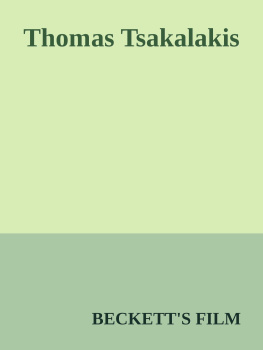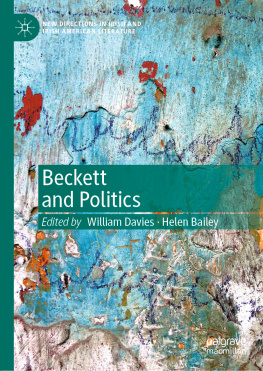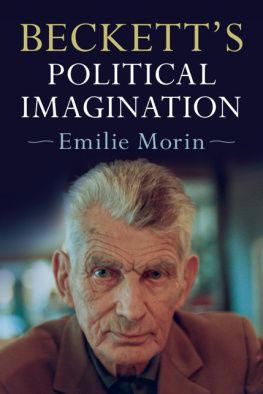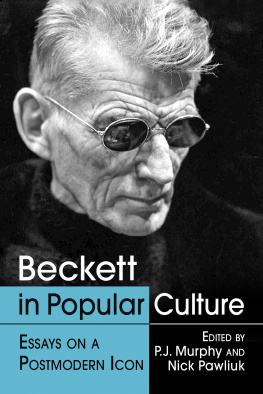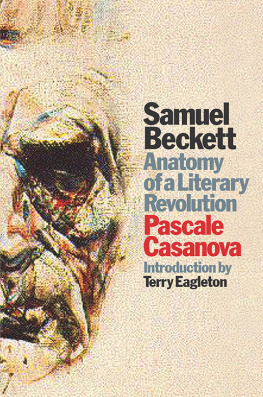BECKETTS DEDALUS: DIALOGICAL ENGAGEMENTS
WITH JOYCE IN BECKETTS FICTION
P.J. MURPHY
Becketts Dedalus
Dialogical Engagements with Joyce in Becketts Fiction

University of Toronto Press Incorporated 2009
Toronto Buffalo London
www.utppublishing.com
Printed in Canada
ISBN 978-0-8020-9796-5

Printed on acid-free paper
Library and Archives Canada Cataloguing in Publication
Murphy, P. J. (Peter John), 1946
Becketts Dedalus : dialogical engagements with Joyce in Becketts fiction / P.J. Murphy.
Includes bibliographical references and index.
ISBN 978-0-8020-9796-5
1. Beckett, Samuel, 19061989 Criticism and interpretation. 2. Beckett, Samuel, 19061989 Fictional works. 3. Joyce, James, 18821941 Influence. 4. Joyce, James, 18821941. Portrait of the artist as a young man. I. Title.
PR6003.E282Z7834 2008 848.91409 C2008-904623-4
Krapps Last Tape, Copyright 1958 by Samuel Beckett; Ohio Impromptu, Copyright 1982 by Samuel Beckett. Used by permission of Grove/Atlantic, Inc. Three Novels, Copyright 1955, 1956, 1958 by Grove Press, Inc. Used by permission of Grove/Atlantic, Inc.
University of Toronto Press acknowledges the financial assistance to its publishing program of the Canada Council for the Arts and the Ontario Arts Council.
This book has been published with the help of a grant from the Canadian Federation for the Humanities and Social Sciences, through the Aid to Scholarly Publications Programme, using funds provided by the Social Sciences and Humanities Research Council of Canada.
University of Toronto Press acknowledges the financial support for its publishing activities of the Government of Canada through the Book Publishing Industry Development Program (BPIDP).
For my great-nephews Samuel and James Bryce, identical twins, born London, England, 30 July 2003
Must we wring the neck of a certain system in order to stuff it into a contemporary pigeon-hole, or modify the dimensions of that pigeon-hole for the satisfaction of the analogymongers?
Samuel Beckett, Dante Bruno . Vico .. Joyce
Acknowledgments
Becketts Dedalus grew out of a Social Sciences and Humanities Research Council (SSHRC) grant I received for a projected study of Becketts aesthetics. This quickly turned into a study of Joyces influence on Beckett, which remains one of the great unanswered questions in Beckett studies. My article Portraits of the Artist as a Young Critic: Becketts Dante Bruno . Vico .. Joyce and the Rewriting of Joyce in Assumption in the Journal of Beckett Studies (1999) staked out this territory by showing the extensive degree to which Beckett was influenced by Joyce at the very beginning of his career. The chapter version is half again as long as the original article, moving beyond the descriptive identification of particular Joycean allusions and echoes to an encompassing argument about how to reread Becketts prose works in light of an abiding Joycean influence that progressed through a number of distinctive phases over Becketts lifetime of writing.
Above all, I have to acknowledge a special debt to the students in my English 416 class, Topics in Modern Irish Literature: Joyce and Beckett. I devised this course in order to test out whether or not there would be enough material to extend my JOBS article to a full-scale investigation of Joyces impact on Becketts prose. Several students made particular contributions to points in this study and deserve special acknowledgment: Jessica Michell for Mr Kellys folding and unfolding of his crimson kite, just as the crimson flower unfolds in Stephen Dedaluss theory of artistic creation; Keith Haughton for locating Watts chair in Portrait; Jenna McManus for focusing on Arsene as a feathered biped whose epiphany can be compared to that of the birdgirl in Portrait; and Jean Nelson for noting parallel images in Davins tale in Portrait and in Molloys recounting of his stay at Sophie Lousses. I would also like to thank David Melnyk for his suggestion to me at a University of Reading Beckett Seminar (2003) that Becketts It is not of Dante and the Lobster fame had its source in Stephens aesthetic speculations in Portrait.
Jill McConkey, my editor at University of Toronto Press, supplied encouragement, much astute advice, and professional guidance as this study worked its way through the publication review process. The anonymous reviewers offered perceptive and challenging insights, especially with regard to maintaining the distinction between Stephen Dedaluss aesthetic theories and those of his creator; further development of this fundamental difference proved critical in my revisions. Charles Stuarts careful copy-editing was also greatly appreciated. Colleagues at Thompson Rivers University encouraged me in various ways during the work on this project. Nick Pawliuk was a most patient and tolerant sounding board for many of the ideas developed in this study, as well as a valuable source for bibliographic references on particular topics I was engaged with. Bruce Baugh pinpointed the exact reference in Hegel for Morans famous It is midnight/It was not midnight conundrum. Robert Kroetsch was a source of inspiration when he was writer-in-residence at TRU several years ago. He remembered for me how each new Beckett book had acted as a kind of liberation for him, sanctioning how things could now be done in a new way (he was also pleased to have someone recognize his Beckett allusion in Voice/ in prose: effing the ineffable). My colleague Will Garrett-Pettss discussion of the frozen word trope in Kroetsch and other Canadian post-modern writers in PhotoGraphic Encounters offered alternatives to the rhetorical device of ekphrasis and counterpointed my own efforts to show how Beckett reconstructed and reconfigured the modernist revelation in order to allow for a sense of the temporal. Likewise, my colleague George Johnsons Dynamic Psychology in Modernist British Fiction was a stimulating counterpoint to my discussion of the importance of kinesis in Becketts aesthetic. Finally, thanks to my friend and colleague Alex Forbes for his much appreciated encouragement over the years of my work on Beckett. And as always to Jennifer for her abiding support.
Abbreviations
Beckett Editions
CP
Collected Poems in English and French. New York: Grove, 1977.
CSP
The Complete Short Prose 19291989, ed. S.E. Gontarski. New York: Grove, 1995.
Dis
Disjecta: Miscellaneous Writings and a Dramatic Fragment, ed. Ruby Cohn. New York: Grove, 1984.
Dr
Dream of Fair to Middling Women, ed. Eoin OBrien and Edith Fournier. Dublin: Black Cat, 1992.
HII
How It Is. New York: Grove, 1964.
MC
Mercier and Camier. New York: Grove, 1974.
MPTK
More Pricks Than Kicks. New York: Grove, 1972.
Mur
Murphy. New York: Grove, 1957.
NO
Nohow On (Company, Ill Seen Ill Said, Worstward Ho), intro. S.E. Gontarski. New York: Grove, 1996.
Pr
Proust. New York: Grove, 1957.
Tr (M, MD, Un)
Trilogy (Molloy, Malone Dies, The Unnamable). New York: Grove (Evergreen dition), 1991.
W
Watt. New York: Grove, 1959.
Next page

